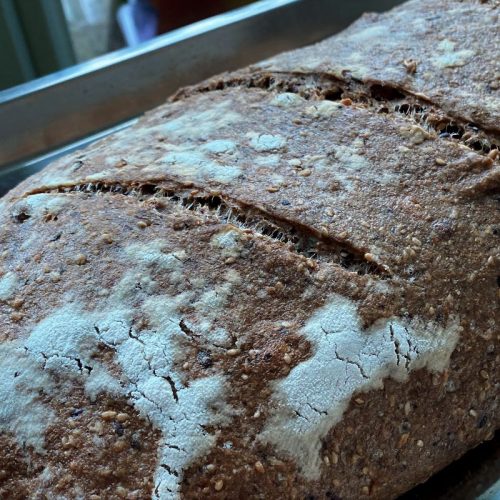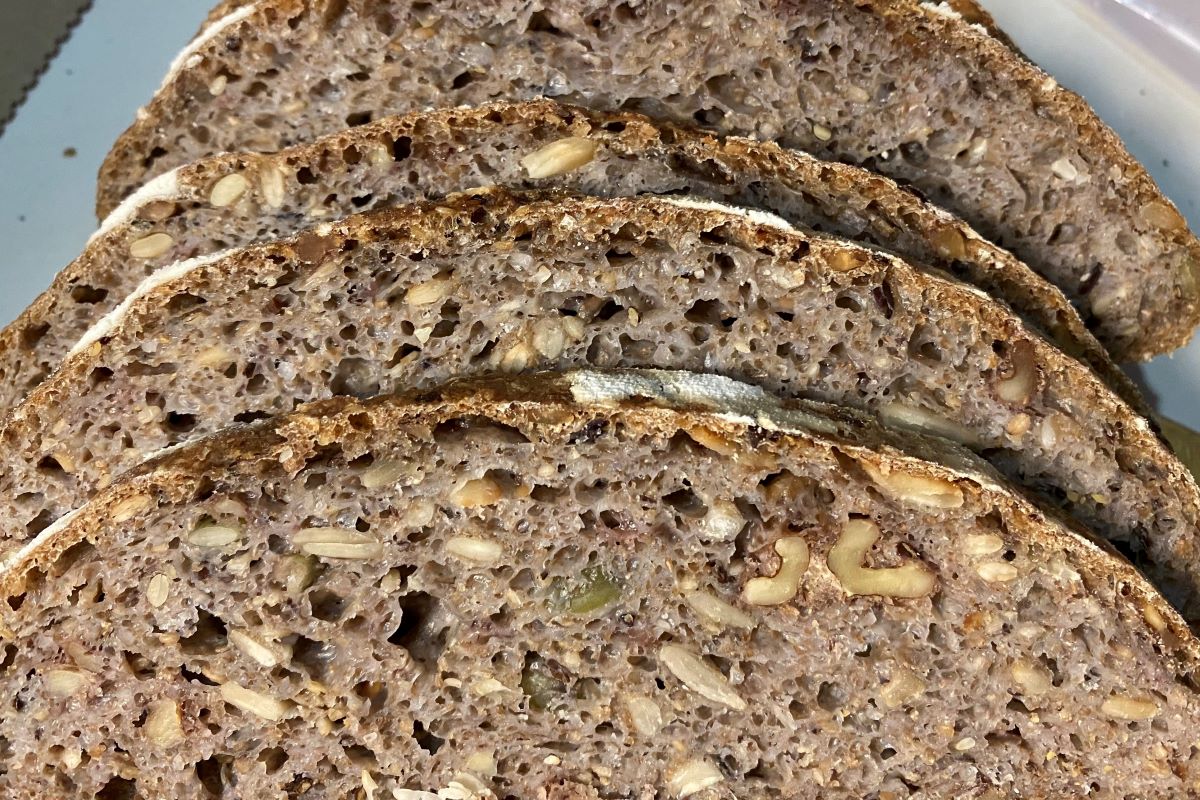Sourdough multi-grain and seed bread is our high hydration sourdough version of our multi-grain and seed bread. It provides fibers, whole nuts and seeds and some full grains as well. The larger amount of water in this recipe together with the sourdough starter makes the fully loaded bread still airy.
The art of making sourdough multi-grain and seed bread
Ingredients for this multi-grain and seed bread are often available locally or in international stores with imported products. Sometimes cracked rye is not available. If there is no cracked rye, either use full rye kernels that have been soaked in water for 2 hrs or substitute by whole grain (dark) rye flour. But the hard winter wheat white flour is pretty essential to create a sufficiently risen (airy) bread. As a substitute, use all purpose flour to which sufficient gluten have been added (see remarks).
We proof this bread in loaf pans, that have a cloth inside and in the refrigerator. But we bake it on a baking plate or stone. This allows for a better crust development.
After the bake and cooling down, it is sliced and frozen in re-sealable bags.
Special equipment
- loaf pan (1 ft x 5 inch; 30 cm x 12.7 cm)
- baking sheet or baking stone

Sourdough multi-grain and seed bread
For 3 loafs, triple the amounts.
Ingredients
Ingredients for making the sourdough starter
- 7.1 oz (200 g) barm cold from the fridge is fine
- 3.5 oz (100 g) whole wheat flour high protein content (over 15%)
- 3.5 oz (100 g) bread flour high protein content (over 13%)
- 7.1 oz (200 g) luke warm (purified) water
Ingredients for making the autolysis
- 21.3 oz (600 g) starter (see above); all of it
- 3.5 oz (100 g) very strong white bread flour (protein content 14.9 %)
- 1.76 oz (50 g) crushed buckwheat
- 2.46 oz (70 g) dark rye flour
- 5.2 oz (150 g) whole wheat flour
- 1.06 oz (30 g) flaxseed meal (ground flaxseeds)
- 1.76 oz (50 g) white or yellow sesame seeds
- 1.41 oz (40 g) pumpkin seeds
- 2.82 oz (80 g) sunflower seeds (unflavored for baking)
- 2.1 oz (60 g) walnuts (pieces)
- 0.3 oz (8 g) salt
- 13.1 oz (370 g) water purified (no chlorine)
Ingredients for the full loaf
- 21.3 oz (600 g) (all) of the sourdough starter (see above)
- all autolysis ingredients
Instructions
Instructions for making the sourdough starter
- For the starter, mix the solid ingredients in a large enough bowl, then add the water and continue to mix until the mixture is a very, very thick porridge and all flour is moist. Thereafter add the barm. Mix thoroughly, so that the mixture becomes homogeneous.
- Let it ferment at room temperature covered with plastic wrap or covered by a plate until it is very bubbly (2-5 h) and the volume has more than doubled.
Instructions for making the autolysis and the bulk fermentation
- While the pre-ferment is rising, toast the sesame seeds in a skillet, tossing and mixing until they are two shades darker (3-5 min). Let them cool.
- Also toast the sunflower seeds, while tossing them around and let them cool
- Toast the flax seeds until they start to pop and let them cool down
- Grind the flax seeds to meal in a mortar and pestle and mix them with the flour
- Grind the buckwheat in the mortar and pestle and add them to the flour mixture
- Mix all the other dry ingredients including the cooled sesame seeds in the flour mixture in a large enough bowl, that can also accommodate all the water, all the starter mixture and then still allows for the dough to rise
- About an hour before the starter reaches its top, add the water to the flour/nut and seed mixture and mix well. The autolysis due to the wetting of the mixture will help the dough to become more extensible.
- Add the sourdough starter when ready and start to mix with the spatula or a fork. You can do this by taking a part of the dough mixture with your fork or spatula to the other side of the bowl. The dough should stretch like chewing gum in this exercise. Repeat this for a few minutes until all is mixed well.
- Now the main -bulk- fermentation will happen. As to build enough gluten strength to this dough, every 20-30 minutes, make a full fold of the dough. A full fold is starting north with wetted fingers grabbing the dough and stretching it up and then folding it towards you in the south direction. Then turn the bowl 180 degrees and repeat (so you are stretching the dough again and folding it back). Then turn the bowl 90 degrees and repeat. And then turn the bowl 180 degrees and repeat again. That is one full fold.
- You will see the dough rise and with every fold it becomes more difficult to complete the last part of the fold completely. When the dough has risen 2-2.5 times in volume, shape the dough
- I use a tea towel in a loaf pan that has been lightly sprinkled with some flour. I fold the dough carefully with floured fingers, so it can nicely fit in the loaf pan. keep the fold wrinkles up on top.
- You can let it proof for a little while more at room temperature until the dough has risen sufficiently for a 2-2.5 volume increase (from the original volume). Then cover with some plastic wrap, oiled with a little oil. Retard in the refrigerator, where the rising will slow down. Bake the bread the next day
Instructions for baking the loaf
- The next morning, take the loaf pan out of the refrigerator and let warm up at ambient temperature for an hour.
- Pre-heat the oven to 482 F (250 C) and just before placing the loaf pan in the oven set the thermostat to 392 F (200 C) and pre-steam the oven. [Thus the initial temperature the loaf is exposed to is 482 F (250 C), but the first several minutes there will be no heating coils on, so the oven spring can take place undisturbed].
- Carefully remove the dough from the loaf pan (by placing it upside down on a baking plate). Make a few cuts 1/2 inch deep in the dough, using a sharp, oiled knife
- Place the loaf in the middle of the oven, immediately adding some steam or hot water to the oven and bake for 1 h with the thermostat first at 392 F (200 C) and later at 356 F (180 C). Look at the color of the loaf to determine when to do this. Every oven is different.
- You may observe that the loaf is still rising during the first 20 min of your bake. Therefore it is important to steam the oven at the beginning. The steam will condensate on the cold dough surface and make it stretchable. The scores in the bread will further aid the oven spring. Prevent heat from above during the first 20 minutes of your bake.
- After 1 h take the loaf out of the oven using mitts and let it cool on a rack. .
- Let the bread cool down uncovered for more than 2 h before slicing. Then slice the bread to the extent is needed for the meal.
- Optionally freeze the fully sliced bread and take out over time what you need. Frozen bread can be revitalized in a toaster or in a pan with a lid.
Notes
Remarks
- The protein content on the package indicates the gluten content. Aim in this recipe for 14.5-15% proteins in the white bread flour. See also Cooking hints, bread, noodles,dough and batter to understand how to increase the protein content of your white (bread) flour.
- For making the barm, see our recipe sourdough barm for high hydration breads.



